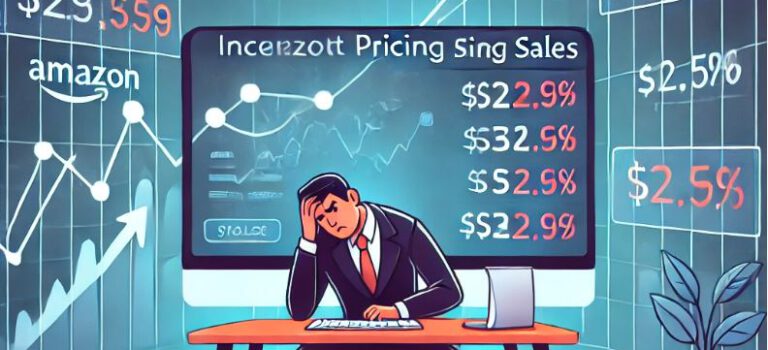Are you pricing to win, or pricing to fail? Too many Amazon sellers overlook the power of pricing, treating it as an afterthought rather than the strategic lever it truly is. The result? Sales that stagnate, profits that shrink, and inventory that collects dust. It’s time to get serious about your pricing strategy—because on Amazon, pricing can make or break your business.
The Cost of Getting Pricing Wrong
On Amazon, price is more than a number; it’s a signal. A bad pricing strategy can send the wrong message to customers, bury you in Amazon’s rankings, and lead to lost sales. Price too high, and you scare off potential buyers. Price too low, and you cut into your margins, turning your hard work into a charity.
Solution: Think Like a Strategic Marketer, Not a Bargain Hunter
- Understand Your Costs: Before you can price competitively, you need to know your costs down to the penny. This includes manufacturing, shipping, Amazon FBA fees, and any other associated expenses.
Tip: Use Amazon’s FBA Revenue Calculator to get a precise breakdown of fees and profit margins.
- Check the Competition: Keep a close eye on your competitors. Tools like Keepa and CamelCamelCamel can help you track historical pricing trends and understand how similar products are being priced. This gives you a clearer picture of what the market can bear.
- Choose the Right Pricing Model: Decide whether to go with cost-plus pricing (adding a markup to your costs), value-based pricing (based on perceived customer value), or competitive pricing (based on what competitors charge). Each has its place—choose the one that aligns with your goals.
Don’t Race to the Bottom: Why Undercutting Isn’t Always the Answer
Many Amazon sellers make the fatal mistake of constantly lowering their prices to outdo the competition. This is a losing game that squeezes your profit margins and sets unrealistic customer expectations.
Practical Tip: Focus on building perceived value instead of slashing prices. Highlight premium features, exceptional customer service, or unique selling points that justify a higher price.
Dynamic Pricing: The Secret Weapon to Stay Ahead
Amazon is a fast-paced marketplace. What worked yesterday might not work tomorrow. That’s why many successful sellers use dynamic pricing—adjusting prices in real-time based on market conditions, competitor actions, and inventory levels.
Solution: Use Tools to Automate Pricing Adjustments
- Implement Repricing Tools: Software like RepricerExpress, Sellery, or BQool can automatically adjust your prices based on competitors and inventory levels, helping you maintain the perfect price point for profit and ranking.
- Monitor Price Elasticity: Experiment with different price points to understand how sensitive your customers are to price changes. Use A/B testing to find the optimal balance between volume and profit.
Psychological Pricing: Tactics That Drive Sales
Price isn’t just about numbers; it’s about psychology. A well-chosen price can trigger a buying decision faster than any fancy description or stunning image.
Solution: Use These Proven Psychological Pricing Techniques
- Charm Pricing: Ever wonder why $19.99 works better than $20.00? Prices ending in “.99” are perceived as significantly cheaper. Use this to your advantage.
- Anchor Pricing: Display the original price next to the discounted one. This creates a perception of value and urgency.
Example: “Was $49.99, now only $34.99—save 30%!”
- Bundle Pricing: Offer discounts for multi-item purchases or create product bundles. This encourages higher average order values and reduces decision fatigue.
Repricing Frequency: Avoid Constant Adjustments
Constant price changes can lead to confusion and erode customer trust. Amazon’s algorithm doesn’t favor erratic pricing, either. Balance is key.
Practical Tip: If you’re using a repricing tool, set rules for how often adjustments can occur. Don’t go overboard—consistency breeds trust.
Conclusion: Price for Profit, Not Just for Sales
Your pricing strategy on Amazon is one of your most powerful tools. It affects your brand perception, sales volume, and profitability. Stop using pricing as a blunt instrument, and start using it as a precise, strategic tool. Be smart, be adaptable, and above all, be intentional.
Final Takeaway:
Treat your pricing like an investment. Don’t be afraid to test, adjust, and find that sweet spot where sales and profits converge. Because on Amazon, the right price isn’t just about winning the Buy Box—it’s about winning the customer.

